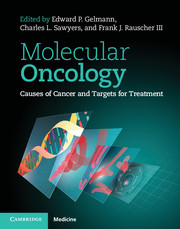Book contents
- Frontmatter
- Dedication
- Contents
- List of Contributors
- Preface
- Part 1.1 Analytical techniques: analysis of DNA
- Part 1.2 Analytical techniques: analysis of RNA
- Part 2.1 Molecular pathways underlying carcinogenesis: signal transduction
- Part 2.2 Molecular pathways underlying carcinogenesis: apoptosis
- Part 2.3 Molecular pathways underlying carcinogenesis: nuclear receptors
- Part 2.4 Molecular pathways underlying carcinogenesis: DNA repair
- Part 2.5 Molecular pathways underlying carcinogenesis: cell cycle
- Part 2.6 Molecular pathways underlying carcinogenesis: other pathways
- Part 3.1 Molecular pathology: carcinomas
- Part 3.2 Molecular pathology: cancers of the nervous system
- Part 3.3 Molecular pathology: cancers of the skin
- Part 3.4 Molecular pathology: endocrine cancers
- Part 3.5 Molecular pathology: adult sarcomas
- Part 3.6 Molecular pathology: lymphoma and leukemia
- 68 Molecular pathology of lymphoma
- 69 The molecular basis of acute myeloid leukemia
- 70 Molecular oncology of acute promyelocytic leukemia (APL)
- 71 Acute lymphoblastic leukemia (ALL)
- 72 B-cell chronic lymphocytic leukemia
- 73 Chronic myeloid leukemia: imatinib and next-generation ABL inhibitors
- 74 Multiple myeloma
- 75 EMS: the 8p11 myeloproliferative syndrome
- 76 JAK2 and myeloproliferative neoplasms
- Part 3.7 Molecular pathology: pediatric solid tumors
- Part 4 Pharmacologic targeting of oncogenic pathways
- Index
- References
72 - B-cell chronic lymphocytic leukemia
from Part 3.6 - Molecular pathology: lymphoma and leukemia
Published online by Cambridge University Press: 05 February 2015
- Frontmatter
- Dedication
- Contents
- List of Contributors
- Preface
- Part 1.1 Analytical techniques: analysis of DNA
- Part 1.2 Analytical techniques: analysis of RNA
- Part 2.1 Molecular pathways underlying carcinogenesis: signal transduction
- Part 2.2 Molecular pathways underlying carcinogenesis: apoptosis
- Part 2.3 Molecular pathways underlying carcinogenesis: nuclear receptors
- Part 2.4 Molecular pathways underlying carcinogenesis: DNA repair
- Part 2.5 Molecular pathways underlying carcinogenesis: cell cycle
- Part 2.6 Molecular pathways underlying carcinogenesis: other pathways
- Part 3.1 Molecular pathology: carcinomas
- Part 3.2 Molecular pathology: cancers of the nervous system
- Part 3.3 Molecular pathology: cancers of the skin
- Part 3.4 Molecular pathology: endocrine cancers
- Part 3.5 Molecular pathology: adult sarcomas
- Part 3.6 Molecular pathology: lymphoma and leukemia
- 68 Molecular pathology of lymphoma
- 69 The molecular basis of acute myeloid leukemia
- 70 Molecular oncology of acute promyelocytic leukemia (APL)
- 71 Acute lymphoblastic leukemia (ALL)
- 72 B-cell chronic lymphocytic leukemia
- 73 Chronic myeloid leukemia: imatinib and next-generation ABL inhibitors
- 74 Multiple myeloma
- 75 EMS: the 8p11 myeloproliferative syndrome
- 76 JAK2 and myeloproliferative neoplasms
- Part 3.7 Molecular pathology: pediatric solid tumors
- Part 4 Pharmacologic targeting of oncogenic pathways
- Index
- References
Summary
B-cell chronic lymphocytic leukemia (CLL), the most frequent leukemia in the Western world, is characterized by extremely variable clinical courses with survivals ranging from 2 to 20 years. The pathogenetic factors playing a key role in defining the biological features of CLL cells, hence eventually influencing the clinical aggressiveness of the disease, can be divided into “intrinsic factors,” mainly genomic alterations of CLL cells, and “extrinsic factors,” responsible for micro-environmental interactions of CLL cells; this latter group includes interactions of CLL cells occurring via the surface B-cell receptor (BCR) and dependent on specific molecular features of the BCR itself and/or on the presence of the BCR-associated molecule ZAP-70, or via other non-BCR-dependent interactions, e.g. specific receptor–ligand interactions, such as CD38–CD31 or CD49d–VCAM.
Intrinsic factors
It is a common notion that, differently from other B-cell lymphoid neoplasms, CLL is characterized by recurrent DNA gains and losses, and not by the presence of specific chromosomal translocations. However, using improved protocols to obtain informative metaphases (1,2) or microarray-based comparative genomic hybridization (3), chromosomal abnormalities can now be shown in over 90% of patients (2). Only 20% of the events are balanced translocations, whilst the vast majority of them are unbalanced translocations, determining losses or gains of genomic material (1,2). Specific genomic events are associated with a different clinical outcome, and, not surprisingly, the frequency of specific genomic events varies between CLL bearing mutated (M) and unmutated (UM) immunoglobulin heavy-chain variable (IGHV) genes (see below for IGHV molecular features). The recurrent chromosomal aberrations are summarized in Table 72.1.
- Type
- Chapter
- Information
- Molecular OncologyCauses of Cancer and Targets for Treatment, pp. 786 - 792Publisher: Cambridge University PressPrint publication year: 2013

